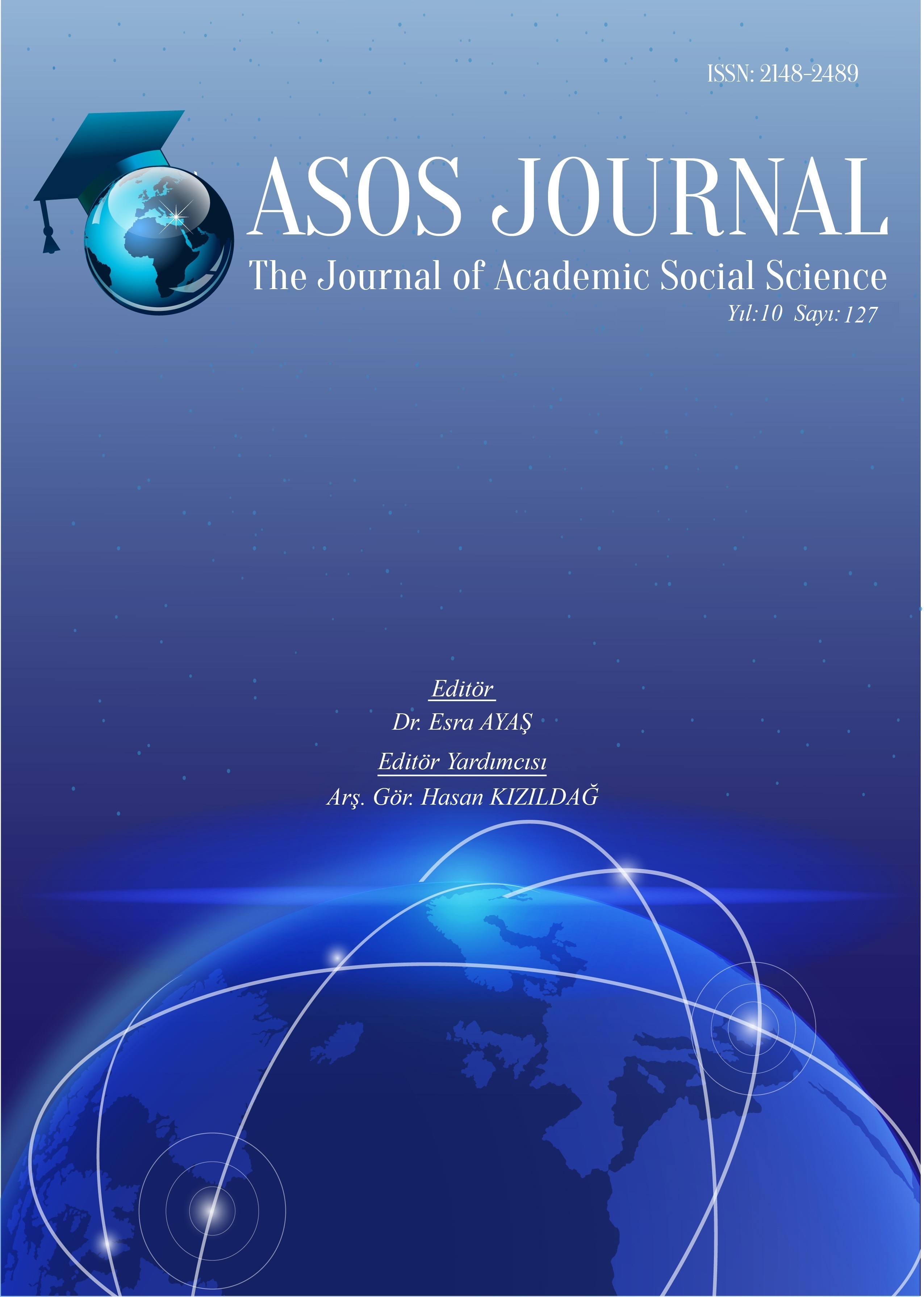Author :
Abstract
Tarihte Balkan dilleriyle Türkçenin yüzlerce yıllık ilişkisi etkileşimi söz konusudur. Son olarak kabaca 14-19. yüzyıllar arasında yaklaşık 500 yıllık bir Oğuz Türkçesi konuşan Osmanlı Devletinin Balkan hakimiyeti yaşanmıştır. Bu dönemde aslen Türkçeden veya Türkçeyle binlerce kelime taşınmıştır. 1878’de Osmanlı Devletinin siyasi olarak çekilmesinden sonra bölgede Almanca, Rusça, Fransızca ve son olarak İngilizcenin etkisi görülmüştür. Aradan geçen 144 yıl içerisinde Türkizmlerin kullanım sıklığında ciddi bir gerileme yaşanmıştır. Türkizmlerin kullanım sıklığının gerilemesi üzerine yeterli araştırma yapılmış değildir. Yapılan sınırlı sayıdaki çalışma da yazılı kaynaklar üzerinedir. Çalışma bu yönüyle bildiğimiz kadarıyla bir ilktir. Bu yönüyle oldukça değerlidir. Araştırmada Saraybosna’da nesillerarası kullanım sıklığını belirlemek için 142 kişiye yüzyüze yapılandırılmış bir anket uygulanmıştır. Anket Saraybosnadaki müslüman etnisite ile sınırlandırılmıştır. Ankette katılımcılara toplam on temel sahadan beş çok bilinir ve beş az bilinir kelime olmak üzere 100 soru sorulmuştur. Anket sonucunda en fazla bilinen kelimelerin yemekler ve akrabalıklar alanlarında olduğu tespit edilmiştir. Eğitim seviyesi yükseldikçe ve yaş ilerledikçe bilinirlik oranlarının da arttığı görülmüştür. Ayrıca elde edilen veriler tablolar hâline getirilip yorumları yapılmıştır.
Keywords
Abstract
There is a centuries-old interaction between Balkan languages and Turkish in history. Finally roughly between 14-19’th centuries, the Balkan domination of the Ottoman State, which spoke Oghuz Turkish for about 500 years, was experienced. During this period, thousands of words were loaned from or through Turkish. After the political withdrawal of the Ottoman Empire in 1878, the influence of German, Russian, French and finally English was seen in the region. In the past 144 years, there has been a serious decline in the frequency of use of Turkisms. There has not been enough research on the decline in the frequency of use of Turkisms. A limited number of studies are also on written sources. In this respect, the study is a first to the best of our knowledge. In this respect, it is very valuable. In the research, a face-to-face structured questionnaire was applied to 142 people to determine the frequency of intergenerational use in Sarajevo. The survey was limited to the Muslim ethnicity in Sarajevo. In the survey, participants were asked 100 questions, five well-known and five less-known words, from a total of ten basic areas. As a result of the survey, it was determined that the most known words were in the fields of food and kinship. It has been observed that frequency rates increase as the education level increases and the age increases. In addition, the obtained data were figured in tables and interpreted.
Keywords
- Balaban, A. ve Ekrem, A. (2013). Arnavutluk’taki Dilde Sadeleştirme Çalışmalarında Metin Altı Sözlüklerin Fonksiyonu. Balaban, A. ve Çağlayan, B. (Ed.), Uluslararası Dil ve Edebiyat Kongresi Balkanlarda Türkçe Tebliğleri İçinde, (s.s. II/8-14). Beder University.
- Filipiç, K. (2016). Boşnakça, Hırvatça ve Sırpçaya Türkçe Vasıtasıyla Geçen Arapça ve Farsça Kelimelerin Ses, Şekil ve Anlam Bakımından İncelenmesi. Yayımlanmamış Yüksek Lisans Tezi, İstanbul Üniversitesi Sosyal Bilimler Enstitüsü.
- İyiyol, F. (2009). Türkiye-Bosna Hersek İlişkilerinin Gelişmesinde Halk Kültürünün Rolü, International Symposium on Sustainable Development İçinde, (ss. 380-386), Saraybosna.
- Škaljić, A. (1966). Turcizmi U Srpskohrvatskom Jeziku. Svjetlost Izdavačko Preduzece.
- Suciu, E. (2014). The Turkish Influence on the Romanian Language. Revista de Lingvistică și Cultură Românească, 1, (https://limbaromana.org/en/the-turkish-influence-on-theromanian-language/)
- Süleymanoğlu Yenisoy, H. (1983). Kriçim Türklerinin Düğün Türküleri. II. Milletlerarası Türk Folklor Kongresi Bildirileri 1981, (ss. III: 349-366), Gazi Üniv. Basın-Yayın Yüksekokulu Basımevi.
- Süleymanoğlu Yenisoy, H. (1997). Türk-Bulgar Dil İlişkilerine Toplu Bir Bakış. Bilig. 4, 170- 175.
- Süleymanoğlu Yenisoy, H. (1999). Türkiye'deki Bulgaristan Göçmenlerinin Dil Sorunları Var mı? (Sosyolengüistik Araştırma), (s.s. II: 569-573). Üçüncü Uluslararası Türk Kültürü Kongresi Bildirileri 25-29 Eylül 1993 İçinde Ankara, Atatürk Kültür Merkezi Yayınları.
- Tuğuz, Z. (2016). Sırpçadaki Türkçe Sözcüklerin Türkçe Öğrenen Sırpça Konuşurlara Katkısı. Belleten, 64(1), 139-146.
- Yalap, H. (2016). Türkçeden Sırpçaya Geçen Kelime ve Eklerle Bu Unsurların Sırplara Türkçe Öğretimindeki Katkısı, Türklük Bilimi Araştırmaları Dergisi, 39, 239-259.
- Yücel, D. (2020a). Arnavut Dilindeki Türkizmler Üzerine Yapılan Çalışmalara Bir Çerçeve, Değerlendirme Ve Kaynakça Denemesi. Asos Journal Akademik Sosyal Araştırmalar Dergisi, 8(104), 193-230. DOI: http://dx.doi.org/10.29228/ASOS.41998
- Yücel, D. (2020b). Bulgar Dilindeki Türkizmler Üzerine Yapılan Çalışmalara Bir Çerçeve, Değerlendirme Ve Kaynakça Denemesi. Akademik Sosyal Araştırmalar Dergisi, 7(46), 380-419. Doi:http://dx.doi.org/10.29228/SOBIDER.43372
- Yücel, D. (2020c). Romencedeki Türkizmler Üzerine Yapılan Çalışmalara Bir Çerçeve, Değerlendirme Ve Kaynakça Denemesi. Journal of Research in Turkic Languages, 2(1),21-52. DOI: 10.31757/jrtl.212
- Yücel, D. (2020ç). Sırp-Hırvat-Boşnak Dilindeki Türkizmler Üzerine Yapılan Çalışmalara Bir Çerçeve, Değerlendirme Ve Kaynakça Denemesi. Akademik Sosyal Araştırmalar Dergisi, 7(46), 650-698. DOI: http://dx.doi.org/10.29228/SOBIDER.42943
- Yücel, D. (2020d). Yunancadaki Türkizmler Üzerine Yapılan Çalışmalara Bir Çerçeve, Değerlendirme Ve Kaynakça Denemesi. The Journal of Kesit Academy, 6(23), 169-197. DOI: 10.29228/kesit.42829
- Yücel, D. (2021). Makedon Dilindeki Türkizmler Üzerine Yapılan Çalışmalara Bir Çerçeve, Değerlendirme Ve Kaynakça Denemesi. Kesit Akademi Dergisi, 7 (26), 182-213. DOI:10.29228/kesit.49221





